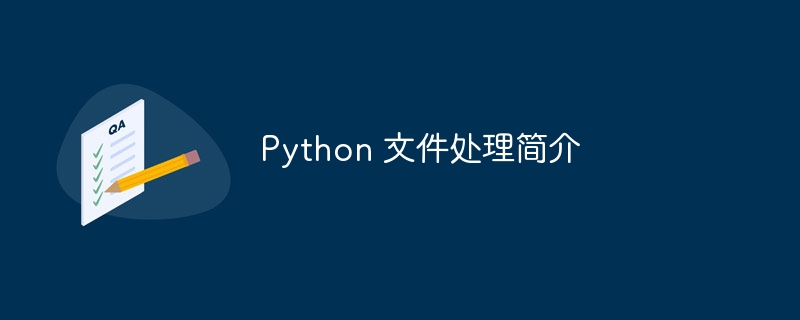◎欢迎参与讨论,请在这里发表您的看法、交流您的观点。
Python 文件处理简介
ID:19605 / 打印
文件处理是使用 python 最重要的方面之一。无论您是阅读文本文档、编写日志、处理 csv 文件还是存储数据,了解如何使用文件都至关重要。幸运的是,python 的内置函数使您可以轻松创建、打开、读取、写入和操作文件,而无需费力。
在本文中,我们将深入探讨 python 中文件处理的基础知识,涵盖从打开文件到处理 csv 和 json 等常见文件格式的所有内容。我们还将分享有关高效处理大文件并确保您安全处理文件的技巧。最后,您将自信地使用 python 来管理项目中的文件。
我们将涵盖的内容:
- 打开和关闭文件
- 从文件中读取
- 写入文件
- 处理二进制文件
- 处理异常
- 使用 os 和 pathlib 进行文件操作
- 使用 csv 和 json 文件
- 高效文件处理技巧
- 文件编码和跨平台注意事项
1. 打开和关闭文件
当您使用文件时,第一步是打开文件。在 python 中,这是使用 open() 函数完成的,该函数有两个主要参数:文件名和打开文件的模式(例如读取“r”、写入“w”或附加“a”) )。完成后,关闭文件以释放资源非常重要。
立即学习“Python免费学习笔记(深入)”;
示例:
# open a file in write mode file = open("example.txt", "w") # write some content to the file file.write("hello, world!") # always close the file after you're done to free up system resources file.close() 说明:
open("example.txt", "w"):以写入模式打开文件 example.txt。如果该文件不存在,python 将创建它。如果确实存在,则会被覆盖。
file.write("hello, world!"):写入字符串“hello, world!”到文件。
file.close():关闭文件,这是确保保存所有更改并释放资源所必需的。
更好的实践:使用 with 语句
with 语句会在您完成后自动关闭文件,因此您无需显式调用 close()。
with open("example.txt", "w") as file: file.write("hello, world!") # the file is automatically closed here, even if an error occurs 说明:
with 语句确保在执行代码块后自动关闭文件,即使代码块内发生错误也是如此。这可以防止意外的数据丢失或资源泄漏。
2. 从文件中读取
python 中有多种读取文件的方法,具体取决于您是要一次读取整个文件还是逐行处理它。
示例(读取整个文件):
with open("example.txt", "r") as file: content = file.read() # read the entire file at once print(content) 说明:
open("example.txt", "r"): 以读取模式打开文件 ("r")。
file.read():将文件的全部内容读入变量content中。这适用于小文件,但对于大文件可能效率低下。
print(content): 将内容输出到控制台。
示例(高效逐行阅读):
with open("example.txt", "r") as file: for line in file: # loop through each line in the file print(line.strip()) # remove trailing newline characters and print the line 说明:
for line in file 循环逐行读取文件,从而提高大文件的内存效率。
line.strip():在打印之前从每行中删除任何前导/尾随空格或换行符。
3. 写入文件
要将数据写入文件,我们使用“w”或“a”模式。 “w”模式会覆盖文件,而“a”会追加到现有内容。
示例(写入文件):
with open("example.txt", "w") as file: file.write("writing a new line of text.") 说明:
open("example.txt", "w"):以写入模式打开文件,如果文件不存在则创建该文件,如果存在则删除内容。
file.write():将字符串写入文件。如果需要,您可以在新行中添加 n。
示例(附加到文件):
with open("example.txt", "a") as file: file.write(" this will be appended at the end.") 说明:
open("example.txt", "a"):以追加模式("a")打开文件,这意味着新数据将添加到文件末尾,而不删除现有内容。
file.write("nthis will beappend at the end."):在文件末尾写入新行,添加 n 移动到新行。
4. 处理二进制文件
处理非文本文件(例如图像、视频或其他二进制数据)时,需要使用二进制模式(“rb”用于读取,“wb”用于写入)。
示例(读取二进制文件):
with open("image.jpg", "rb") as binary_file: binary_data = binary_file.read() # read the entire file in binary mode print(binary_data[:10]) # print first 10 bytes for preview 说明:
open("image.jpg", "rb"):以读取二进制模式("rb")打开文件,这对于二进制数据是必需的。
binary_file.read():读取文件的整个二进制内容。
binary_data[:10]:显示文件的前 10 个字节。这对于预览或处理块中的二进制数据非常有用。
5. 异常处理
处理文件时,可能会发生文件丢失或权限问题等错误。您可以使用 try- except 块优雅地处理这些错误。
示例:
try: with open("nonexistentfile.txt", "r") as file: content = file.read() except filenotfounderror: print("the file does not exist!") 说明:
try 块尝试打开并读取可能不存在的文件。
如果未找到文件,则 except filenotfounderror 块会捕获错误并打印一条用户友好的消息,而不是使程序崩溃。
6.使用os和pathlib进行文件操作
os 和 pathlib 模块提供了与文件系统交互的方法,而不仅仅是打开和关闭文件。您可以检查文件是否存在、重命名或删除它们。
示例(操作系统模块):
import os # check if a file exists if os.path.exists("example.txt"): print("file exists") # rename the file os.rename("example.txt", "new_example.txt") 说明:
os.path.exists("example.txt"): checks if the file example.txt exists. os.rename(): renames the file to new_example.txt. 示例(pathlib 模块):
from pathlib import path file_path = path("new_example.txt") # check if the file exists if file_path.exists(): print("file exists") # deleting a file file_path.unlink() # deletes the file 说明:
path("new_example.txt"):创建一个指向文件的 path 对象。
file_path.exists(): 检查文件是否存在。
file_path.unlink(): 删除文件。
7. 使用 csv 和 json 文件
python 的 csv 和 json 模块可以轻松处理结构化数据格式,例如 csv(逗号分隔值)和 json(javascript 对象表示法)。
csv 文件
csv 模块允许您处理按行和列组织的数据。
示例(写入 csv):
import csv with open("data.csv", "w", newline="") as file: writer = csv.writer(file) writer.writerow(["name", "age"]) # write header row writer.writerow(["john", 30]) # write data rows writer.writerow(["jane", 25]) 说明:
csv.writer(file):创建一个 writer 对象以将行写入 csv 文件。
writer.writerow():将每一行数据写入文件。
示例(读取 csv):
import csv with open("data.csv", "r") as file: reader = csv.reader(file) for row in reader: print(row) 说明:
在上面的代码块中,csv.reader(file):创建一个读取器对象,迭代 csv 文件中的每一行。
读取器循环中的 for row 读取每一行并打印它。
json 文件
json 模块非常适合读取和写入键值对结构的数据。
示例(编写 json):
import json data = {"name": "john", "age": 30} with open("data.json", "w") as file: json.dump(data, file) # serialize dictionary to json 说明:
json.dump(data, file):将字典数据以 json 形式写入文件。
示例(读取 json):
import json with open("data.json", "r") as file: data = json.load(file) # deserialize json to a dictionary print(data) 说明:
json.load(file):读取 json 文件并将其转换回 python 字典。
8.高效文件处理技巧
处理大文件时,分块处理文件比将整个文件加载到内存中更有效。
示例(分块阅读):
with open("largefile.txt", "r") as file 结论
在 python 中处理文件既简单又强大。无论您是处理文本文件、存储数据还是处理大型数据集,掌握文件操作都将使您的编码生活更加轻松。借助我们在本文中介绍的技巧和技术,您将能够顺利编写更高效、可靠且可扩展的 python 程序。
感谢您的阅读...
